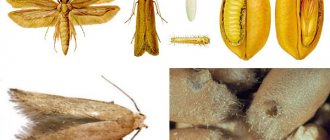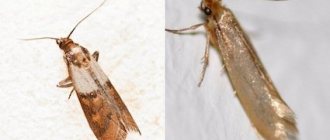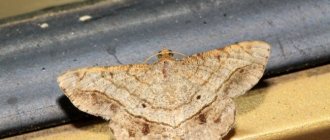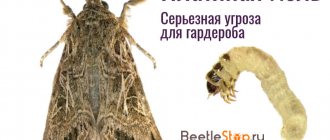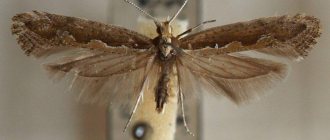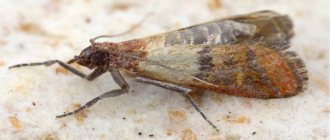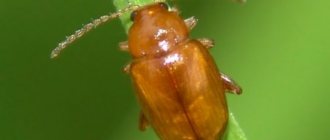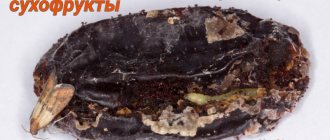Fighting cereal moths takes a lot of time and effort, since highly effective, quick-acting preparations are not suitable for kitchen conditions. And, accordingly, housewives often have questions about how to get rid of moths in cereals and make sure that this pest does not return. Most often, repellents are used to combat these insects, which repel them with their aroma, preventing them from reproducing.
Description, reproduction and lifestyle of the pest
The moth has an inconspicuous appearance and is small in size. The length of the wings rarely exceeds 10 mm. They are characterized by a discreet color - dark gray, brown or beige. Mainly nocturnal in the kitchen.
Butterflies do not need food; they only need water to survive. The adult individual loses the ability to digest food, its main goal becomes laying eggs and preserving its offspring. Food moths have an accelerated reproduction period—two months. High humidity and a temperature of at least 20°C provide a favorable environment for the life of the parasite.
The life cycle of a moth is on average ten days, but this time is more than enough for it to breed a huge number of new pests. The larvae of food moths are small - 1-1.5 cm long. These are white-yellow or pink caterpillars, absolutely smooth, without hairs or growths. They are the ones who cause the most damage. Caterpillars eat food, leaving behind webs and waste products. Pellets form in cereals, and worms appear in nuts and dried fruits.
Not only food moths, but also clothes moths can appear in an apartment. You need to understand how to distinguish them from each other, this will help you quickly find the source of infection. The clothes moth is slightly smaller than its counterpart and has milky-gray wings. He lives in closets and wardrobes, eats clothes, furniture upholstery, and carpets.
It is necessary to get rid of moths immediately after detection, since the worms cause significant damage to food products and multiply at enormous speed.
Peculiarities
Insects live in various corners of the kitchen - in a bowl with flour, cereal, tea or other grocery product. Cereal moth is the name of several varieties of moths, among which fruit, flour, and cocoa moths stand out.
Visually, the grain moth looks like a gray or black butterfly, with triangular-shaped wings with small spots. The size of the insect does not exceed 1 cm. But they do not cause harm; the larvae are dangerous to humans. Consumed contaminated cereals provoke serious intoxication of the body.
Routes of penetration
The ways in which groceries are affected by parasites are varied. Why do pests appear in cereals:
- insects enter the home through open windows;
- at the time of sale, the product already contained moth larvae;
- when using dishes containing nits of insect pests or the remains of contaminated cereals.
Regardless of how the moth entered the container with the bulk mixture, it must be dealt with. Eating contaminated cereals can lead to serious poisoning.
Harm from cereal moths
Consumption of a moth-infested product has a negative effect, first of all, on the human digestive system. Such cereals can cause severe intestinal disorders, as well as severe poisoning of the entire body.
If food moth larvae are identified, pest control must be started immediately. Simply throwing away a bag of spoiled groceries will not help in such a situation, since insects can appear in any other closet or room suitable for their habitat.
Reasons for appearance
In what cereals do moths appear? This depends on the type of insect, among which are body and food parasites.
Food insects most often live in the following places:
- Wheat flour.
- Bakery products.
- Barley and other cereals.
- Tea.
- Nuts.
In addition, the favorite habitat of food moths is containers with dried fruits, so it is also recommended to store them in tightly closed containers made of glass or metal.
Varieties of moths
There are several types of home moth; each group gives preference to its favorite product, but does not neglect others. There are eight main types of household pests.
- Flour moth. The firefly is small in size with beige colored wings. This type of insect reproduces faster than its counterparts. If you notice small cocoons in the flour, it means that the parasite has entered the house. Sift the flour through a sieve, then cook in the oven for at least half an hour. Store flour in an airtight container.
- Grain moth. A firefly with narrow wings of a yellowish tint, the color is similar to the color of grain so that it can blend in with it. She focuses on buckwheat, rice, rye and wheat. The safest way to get rid of the parasite is to use special traps.
- Mill moth. A butterfly up to 1.5 cm in size, with dark gray dotted wings. This type of moth is rarely found in apartments; they are usually found in mills.
- Potato moth. A small, inconspicuous moth with gray wings and long antennae. The larvae like to attack old potatoes, as their tubers are softer. They bite into fruits, causing rotting. You can fight potato moth by adjusting the storage temperature of root crops below 0°C. For a better effect, tubers can be treated with biological preparations.
- Onion moth. Wingspan up to 17 mm. The body and fore wings are brown, the hind wings are gray with fringe. The larvae eat the onion, causing the vegetable to rot.
- Cereal moth. A butterfly with silver-gray wings, the span of which reaches 14 mm. The larva destroys cereals and seeds, gluing the grains into pellets using a web. Its appearance indicates that the grain has already been stored in the warehouse.
- Chocolate moth. Eats coffee, cocoa beans, chocolate and other “confectionery”. She makes passages in chocolate products, leaving behind grains of feces. The size of the worms does not exceed 0.5 cm, so they fit into the smallest holes in the wrapper.
- Fruit moth. The gray butterfly, approximately 10 mm in size, is nocturnal. Moths grow in dried fruits, fruits and mushrooms. Its larvae break through canals, turning the fruits into dust. The insect does not disdain other products, so you can see moths in walnuts, almonds or hazelnuts.
In the apartment, food moths eat all grocery products. Therefore, first check for caterpillars:
- cereals;
- pasta;
- beans;
- peas;
- flour;
- sugar;
- candies;
- nuts and dried fruits;
- bread;
- cookie;
- spices;
- tea;
- coffee;
- cocoa;
- animal feed.
Different types of parasites can easily live next to each other. Therefore, when you find a moth, carefully check not only your food, but also your wardrobe.
Prevention
Housewives are interested in how to store cereals and things in the house so that moths do not appear.
There are a number of rules for this:
- You should not buy a lot of cereals, nuts, tea at once. It is better to replenish supplies as needed.
- Cheap loose cereals may contain insect larvae, so you need to purchase cereals in hermetically sealed packs and bags.
- Periodically check existing supplies for the presence of the parasite and its larvae.
- It is worth storing provisions in glass or metal containers.
- You need to place bunches of aromatic herbs on the kitchen shelves and in the closet. They need to be changed as the smell dissipates.
- After purchasing the cereal, you should immediately bake it in the oven. Old stocks that are not visually infected are also kept there for about 15 minutes. In winter, grains can be frozen as an alternative.
- It is not recommended to create significant accumulations of garbage in the house in the form of old things, carpets, pillows.
Causes of appearance and damage caused
Where do food moths come from in an apartment? The appearance of the pest is not associated with carelessness and sloppiness of the owners. The firefly is a poor flyer; it cannot move long distances. When the caterpillar transforms into a pupa, it crawls to the far corner and waits there for its transformation.
In the warm season, moths can fly into a private house from the street through a window or an open door. It gets into the apartment along with groceries from the store, or crawls through the ventilation from neighbors. Similarly, it starts in grain warehouses, where the largest number of larvae are noticed. Infected cereals are transported from one barn to another, where the larvae immediately begin to destroy the products.
Groceries affected by caterpillars become unfit for consumption. Large warehouses suffer huge losses from food moth infestations. Food stocks in barns cannot be sold. When multiplying, the larvae leave droppings, scales and remnants of cobwebs in the rump. These waste products are toxic, they are harmful to humans, as they can cause severe poisoning.
Very often, unscrupulous manufacturers try to sell contaminated products at low prices. By purchasing a product at a discount, you can not only throw money away, but also bring home a malicious pest.
Video on the topic
Routes of penetration
Many housewives are puzzled by the question of why moths appear in cereals. Moths can get into the house in several ways:
- With contaminated products from a market or store;
- Through a window in the absence of a mosquito net;
- Through the vent.
To minimize the risk of pest butterflies entering your apartment, it is preferable to purchase groceries in large stores rather than at street markets. It is incorrect storage conditions that contribute to the spread of the pest.
How to get rid of food moths in an apartment
Fighting parasites is a rather troublesome process. To get rid of food moths in an apartment forever, all control methods must be used in combination. You should find the source of infection, destroy it, throw away all spoiled groceries and process products that may be contaminated. There are five ways to minimize harm and exterminate the pest.
- Throw away contaminated food. Check all groceries for pests. If you are in doubt whether a product is affected or not, it is better to throw it away than to torment yourself with an eternal struggle with moths. Be sure to check the packaged products - polyethylene is not a hindrance for the larvae.
- Do the washing up. Using laundry soap, thoroughly rinse all containers in which the affected cereal was stored, including adjacent jars.
- Clean out the cabinets. Wipe doors and shelves with vinegar; its pungent smell will repel moths. If the infection was global, treat the interior walls of the furniture with special aerosols.
- Process the cereal and cans. Calcine the cereals in the oven at 80°C, or put the cans of grain in the freezer for three days. If there is a sharp change in temperature, the parasites will die.
- Pour into clean containers. After freezing or reheating, transfer food to new containers with tight lids. Place a clove of garlic in each container to repel parasites.
To avoid causing moths to appear in your apartment, do not leave fruits and berries on the kitchen table. Also, do not stock up on large amounts of groceries for future use.
Folk remedies
Folk remedies have proven themselves well as a “fighter” against moths. They have a pungent odor that repels the pest, but does not rid the food of larvae.
- Garlic. Place a couple of cloves of peeled garlic in the container with the cereal. The female will not like the acrid amber, and she will not want to lay eggs. Garlic does not affect the taste of food.
- Laundry soap. Grate the soap and mix with water. Wash all interior surfaces of cabinets, then rinse and dry.
- Vinegar/lemon juice. Wipe the walls and shelves of cabinets with vinegar, and use a brush for hard-to-reach crevices. Treat with the solution after pre-washing the furniture with laundry soap.
- Lavender. Parasites cannot tolerate the aroma of this plant. Place a couple of branches in the chest of drawers where the cereal jars are. The products will be protected.
- Citrus. The smell of oranges and grapefruits repels moths. Place citrus peels on cabinet shelves or in a kitchen drawer.
- Bay leaf. Cover all groceries with bay leaves - adults do not like this peculiar smell.
- Tobacco. He is afraid of food moths and the smell of tobacco. Place a few cigarettes on the shelves in your closets. This will scare away the female and she will not lay eggs.
- Camphor. The smell of camphor alcohol will remove the parasite from your kitchen for a long time. Dampen a cotton pad with the solution and wipe the inside walls of the cabinet with it.
Remember that treatment with folk remedies will only temporarily protect groceries from pests. Over time, the larvae will develop immunity, and methods of prevention and protection will need to be changed.
Chemicals
When the focus of infestation is strong, professional food moth repellents are needed. Chemical sprays and aerosols are considered effective insecticides on the Russian market.
- "Antimol." The spray is designed for treating kitchen cabinets. After spraying, the effect lasts for a year. Destroys moths of any kind.
- "Raptor". The aerosol helps get rid of not only butterflies, but also larvae. Raptor against food moths is valid for one year.
- "Combat". Copes with all types of moths. The spray is sprayed on furniture and in the corners of the kitchen; it is absolutely safe for pets.
The aerosol helps create a protective barrier and kill pests. It must be used strictly in accordance with the instructions. After treatment, ventilate the room well and thoroughly rinse surfaces that may have been exposed to the spray. Other drugs also help control pests.
- Trap for food moths. The Aeroxon trap, a special odorless product, has proven itself well for catching adult specimens. It is filled with pheromones that attract male food moths. Males fly to the sticky surface, where they die, stopping further reproduction. Sticky traps are non-toxic and absolutely safe for human health. The cost in retail stores fluctuates around 200 rubles (data as of January 2022).
- Repellents. These are special plates, tablets and briquettes. They contain naphthalene, the pungent odor of which repels food moths. The repellent does not destroy the pest, but facilitates its relocation to another territory.
The use of insecticides in residential buildings is not recommended. The high toxicity of these products poses a threat to humans and domestic animals.
What not to use
Some methods used by people should not be used .
- Do not use chewing gum to get rid of moths. The chewing gum contains sugar, and food aphids will be delighted with such a gift.
- Trap using boric acid. The cooking method is simple. Mix boric acid with flour in a proportion of 1 to 3. It is dangerous to use such a solution in the kitchen to get rid of food moths, as an infected insect can carry the poison to the cereal. This poison can end up in human food, which is not desirable.
- It is better not to use insecticides in the kitchen. They are not very effective in getting rid of moths. With their help, you can destroy only visible individuals, and the eggs will remain safe.
Precautionary measures
There is only one way to avoid a debilitating war with food moths - not to let the pest into the house. In addition, complete destruction of the parasite does not guarantee that food moth eggs will not appear in the apartment again. To prevent this from happening, you need to take preventive measures by following six rules.
- Examination. Carefully check the groceries when purchasing, periodically review your supplies in the future, and if necessary, dry them in the oven at low temperature.
- Sealed containers. Store grains and cereals in glass containers with tight-fitting lids.
- Low temperature. The larvae cannot tolerate low temperatures, so keep your groceries in the refrigerator.
- Ventilation. Don't forget to ventilate the kitchen.
- Safety nets. Place ventilation nets on the windows.
- Maintaining cleanliness. At least once a month, do a thorough cleaning of your apartment. This will help prevent the proliferation of parasites in time.
Do not purchase cereals by weight or in unsealed packaging. And if you have already bought it, then put the bag of grain in the freezer for a few days. The pest will no longer be able to reproduce.
Moths can appear in both a country house and an apartment. If you follow the described recommendations, then you will not have problems with how to remove food moths. In the future, do not forget about preventive measures and timely cleaning of the kitchen.
Store funds
If you are interested in how to get rid of kitchen moths in cereals, you should understand that chemicals in the kitchen are extremely undesirable. Bulk products should not come into contact with insecticides, as they very quickly absorb harmful substances and can later lead to poisoning during cooking. Therefore, when choosing store-bought remedies for kitchen moths, you should consider their safety for home residents.
Usually they take tapes with a sticky surface, impregnated with a special composition that attracts the parasite. They are hung in the corners of cereal cabinets. Aeroxon brand traps are presented in the form of a small sticky leaf attached to the door or other surface where the parasite was noticed.
Moths in cereals can be quickly eliminated using the insecticide Reid. But the drug is too toxic. During surface treatment, all food products should be hermetically sealed and removed from the home for the time being. After the procedure, the room should be well ventilated.
Getting rid of adults
In fact, male and female adults do not harm food products, since they do not feed at all, their mouthparts are deformed. But this does not mean at all that there is no need to get rid of them, because they mate and reproduce intensively.
So, to get rid of males, it is effective to use traps; they use the female pheromone, which attracts them. Thanks to the destruction of males, mating and laying eggs becomes impossible.
Regarding females, they are destroyed using chemicals, or in a proven and reliable way, and most importantly in a safe way - with a fly swatter.
We process food stocks
When we got rid of contaminated cereals, the question arises of what to do with the rest of the food supplies that outwardly seem not to be contaminated. If there are very few such grains, then it is certainly better to get rid of them. But you can always resort to simple processing methods, which will allow you to preserve them and not worry about the presence of pests in them.
So, you should pour the cereals onto sheets of paper and sort them thoroughly. Next, put it in the freezer for about 3-4 days. Low temperatures will destroy all insects regardless of development stage.
If it is winter time, you can take them out to the balcony to stay in the cold. High temperatures will also help in processing; to do this, preheat the oven to 60°, pour the product onto a baking sheet and leave for 40 minutes.
Saving food: measures to combat larvae
As we already said, the most effective way to kill the larvae is to throw away all the food. However, if you do not agree to such sacrifices, then it is necessary to secure the remaining supplies.
You can do this in several ways:
- Hand-sort the grains and sift the flour and salt through a sieve.
- Place the food in the freezer for at least three to four days.
- An alternative way is to bake the food in the oven at 60 degrees for 40 minutes. However, this method is not suitable for all types of groceries. For example, the flour will darken or spoil. Semolina will also lose its quality, so this method is recommended only for whole grain cereals.
- If you have a microwave, pour the cereal into a bowl and microwave for 2-3 minutes at maximum power. Like the previous method, this one is only suitable for whole grain cereals.
These methods are very effective, but require careful preliminary mechanical processing of cereals and other products. You need to pick out all the larvae and eggs, otherwise they will remain in the food, even if frozen or baked.
All inventory must be checked manually
In our opinion, not the most appetizing seasoning. Therefore, we advise you to throw away your groceries anyway - cereals, pasta and flour are not that expensive, and the larvae, even if thermally processed, can cause an allergic attack.
